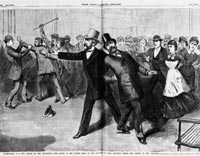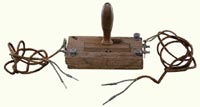

The Death of James A. Garfield

When James A. Garfield was attacked on July 2, 1881, the nation was shocked, enraged, and captivated. President for just four months, Garfield was shot by Charles Guiteau as he was about to board a train at the Baltimore & Potomac Railroad Station in Washington, D.C. Severely wounded, Garfield lingered until September 19.
An unsuccessful lawyer, evangelist, and insurance salesman, Guiteau believed Garfield owed him a patronage position in the diplomatic corps, and that the president's political decisions threatened to destroy the Republican Party. Guiteau was convicted of murder and hanged on June 30, 1882. In 1883 Congress passed the Pendleton Act; it sought to reform civil service and limit the number of patronage seekers like Charles Guiteau.
Assassination
On July 2, 1881, Garfield was about to leave Washington to attend the 25th reunion of his class at Williams College. He was walking through a reception room in the railroad station when a stranger fired two pistol shots at him. Garfield fell, and the assassin cried: “I am a Stalwart and Arthur is President now!”
The assassin, Charles J. Guiteau, was arrested immediately. He held a grudge because Garfield had refused to appoint him as United States consul in Paris. At his trial, Guiteau acted like a madman. His attorney argued that he was innocent by reason of insanity, but a jury convicted him. He was hanged in 1882.
 Bell's Device
Bell's Device
Garfield lay near death for 80 days. Although one of the assassin's bullets had merely grazed his arm, the other had lodged in his back. Surgeons could not find it. Alexander Graham Bell tried unsuccessfully to locate the bullet with an electrical device. Several times they thought they had found the bullet, but it turned out to be the bedsprings underneath the president. Surgeons and doctors constantly probed Garfield with unclean instruments over the days in an attempt to find the bullet, but never did. It was this probing with unclean instruments that led to the blood poisoning that eventually killed the president.
Garfield remained calm and cheerful throughout the hot summer in Washington. He performed only one official act, the signing of an extradition paper. The Constitution provides that, in case of a President's “inability to discharge the powers and duties” of his office, “the same shall devolve on the Vice President.” But this had never happened, and Chester A. Arthur did not step in for fear of disturbing Garfield and creating a major political controversy. The Cabinet supported his decision.
If the X ray and modern antiseptics had existed at that time, Garfield's life might have been saved. But infection set in. After being moved to a seaside cottage in Elberon, N.J., he died on Sept. 19, 1881.







